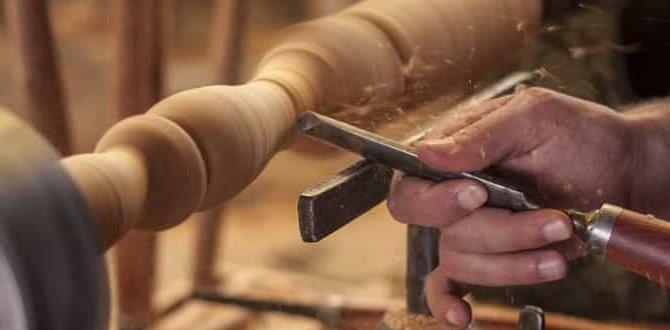Woodturning, a captivating craft that transforms raw timber into intricate designs, inherently involves various risks associated with its tools and techniques. The high-speed rotation of lathe machinery, the sharpness of chisels, and the potential for wood deformities introduce a spectrum of hazards that both novice and seasoned woodturners must navigate. A deeper understanding of these risks, coupled with proper safety measures, is pivotal in mitigating accidents.
Exploring whether woodturning is dangerous is essential for anyone engaged in this art form. Delving into the intricacies of safety, techniques, and equipment can illuminate the path to mastery in this rewarding yet perilous craft.
Is Woodturning Dangerous? Key Risks And Safety Tips

Safety Measures and Precautions
Personal Protective Equipment (PPE) essentials. Tool maintenance and proper handling techniques. Importance of workspace organization and cleanliness.
Understanding the right safety measures is key to enjoying woodturning. First, using the right Personal Protective Equipment (PPE) is essential. Always wear safety glasses, ear protection, and a dust mask to protect yourself from debris and noise. Next, keeping tools in good shape is crucial.
Regular maintenance keeps blades sharp and reduces accidents. Handle tools correctly and never rush. Lastly, maintain a tidy workspace.
A clean area helps you avoid tripping and finding tools easily.
- Wear safety glasses
- Use ear protection
- Wear a dust mask
- Keep tools sharp
- Organize your workspace
Common Injuries in Woodturning
Statistics on woodturningrelated injuries. Types of injuries (e.g., cuts, abrasions, respiratory issues). Reallife case studies or anecdotes.
Woodturning can lead to various injuries, and the statistics show the importance of safety. Many woodturners experience cuts and abrasions from sharp tools. Respiratory issues can arise from dust inhalation. Here are some common injury types:
- Cuts from tools
- Abrasions from wood splinters
- Respiratory issues from fine wood dust
One woodturner shared how a minor cut turned serious due to infection, highlighting the need for caution.
Always remember: safety gear can help prevent serious injuries!
Training and Skill Development
Recommended training programs and courses. Importance of mentorship and practice. Resources for skill enhancement (books, online tutorials).Learning woodturning requires good training and practice. Consider enrolling in local workshops or online courses to get started. Mentorship from experienced woodturners is essential.
They can share tips and help you avoid common mistakes. Regular practice makes you better. Use the following resources to enhance your skills:
- Books on woodturning techniques
- Online tutorials on safety and skills
- Videos demonstrating different projects
These tools will boost your confidence and creativity in woodturning.
Community and Support for Woodturners
Online forums and social media groups. Local woodturning clubs and workshops. Networking opportunities for knowledge sharing and safety tips.
Woodturners can find a strong sense of community and support in various places. Online forums and social media groups allow sharing ideas and experiences. These platforms connect woodturners from all over the world. Local clubs offer hands-on workshops where members can learn together.
In these gatherings, woodturners can network and exchange valuable safety tips. This support system makes woodturning safer and more enjoyable.
- Online forums for sharing knowledge
- Social media for connecting worldwide
- Local clubs for hands-on workshops
- Networking for safety tips and experiences
Conclusion
In conclusion, while woodturning can pose risks, understanding and adhering to safety practices significantly mitigates potential dangers. By using proper equipment, maintaining a clean workspace, and staying vigilant, woodturners can enjoy this rewarding craft with minimal risk. Embracing safety measures not only enhances the craft but also ensures a fulfilling and enjoyable woodturning experience.
FAQs
What Are The Primary Safety Risks Associated With Woodturning?The primary safety risks associated with woodturning include the potential for kickback, which can cause serious injuries if the tool or piece of wood unexpectedly moves. There’s also a risk of lacerations from sharp tools and flying debris, particularly from a malfunctioning lathe. Dust inhalation is another concern, as fine wood dust can lead to respiratory issues over time. Proper safety gear, including eye protection and dust masks, is essential to mitigate these risks.
What Protective Gear Should A Woodturner Wear To Minimize Injuries?A woodturner should wear safety glasses or a full face shield to protect against flying debris and dust. Hearing protection, such as earplugs or earmuffs, is important to guard against noise from machinery. A dust mask or respirator is essential to prevent inhalation of fine wood particles. Finally, wearing gloves and sturdy closed-toe shoes can help protect the hands and feet from potential accidents.
How Can Proper Techniques And Practices Reduce The Danger In Woodturning?Proper techniques and practices in woodturning, such as maintaining a firm grip on the tool, using appropriate speeds, and ensuring a clear workspace, significantly reduce the risk of accidents. Wearing safety gear, like goggles and face shields, protects against flying debris and potential injuries. Regularly maintaining tools and equipment ensures they function effectively, minimizing the chance of malfunctions. Additionally, staying focused and aware of surroundings helps to prevent mishaps.
What Are Some Common Accidents That Can Occur During Woodturning, And How Can They Be Prevented?Common accidents during woodturning include tool slips, kickbacks, and injuries from sanding dust. To prevent these, ensure tools are sharp and properly anchored, maintain a stable stance, and use appropriate personal protective equipment like face shields and dust masks. Regularly check the lathe’s setup for any loose parts and keep the work area organized to avoid tripping hazards. Additionally, always follow proper techniques for tool handling and work with caution when operating machinery.
How Does The Condition Of The Wood Being Turned Affect The Safety Of The Woodturning Process?The condition of the wood significantly impacts the safety of the woodturning process because damaged or unstable wood can lead to unexpected breaks or shifts during turning. Wood with cracks, knots, or defects may shatter or fly off the lathe, posing a risk to the operator. Properly dried and well-prepared wood is essential for maintaining a stable turning experience. Regular inspections and secure mounting of the wood can enhance safety and minimize hazards.
